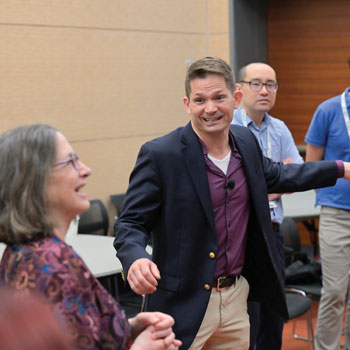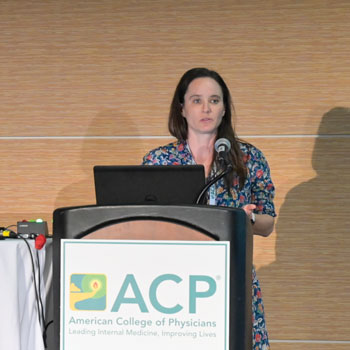Medical improv proves provocative for physicians
Physicians are adapting improvisational theater principles to improve communication, cognition, and teamwork in health care.
A room of physicians got their Hollywood moment at Internal Medicine Meeting 2024 during an improvisational acting class that taught an important lesson about mistakes—there are none.
Mistakes are both a gift and an opportunity, said Carrie A. Horwitch, MD, MPH, MACP, a clinical associate professor of medicine at the University of Washington in Seattle. She quickly got attendees up and moving during the session "Medical Improv: Novel Method to Improve Communication Skills with Empathy."

Dr. Horwitch introduced herself to the audience by saying, "I learned about medical improv at a medical meeting and was so intrigued and engaged that I started taking improv classes, and then working with other colleagues to actually bring this as a workshop to other clinicians, because I think it's fantastic."
She started the workshop with an exercise called "Just Like Me" and asked the doctors to move to an area of the room designated as "yes," "no," or "maybe" in response to a statement or suggestion. It is a way to build curiosity of others in a group, she said.
Next, co-presenter John-Michael Maury, BMEd, manager of the Standardized Patient Program at the University of California, San Diego, School of Medicine, quickly paired off attendees to answer get-to-know-you questions and complete improv drills relevant to all aspects of providing care, directly to patients and also as part of care teams.
Improv can be defined as "cultivated intuition guiding spontaneous action," Mr. Maury said. "That's an important word there, 'spontaneous.' I want you to remember that word," he said. "That really is what improv is all about: being in the moment, reacting to what's going on, actually responding to what's going on."
Improv that is applied to and utilized in health care education and professional development is also called medical improv, a term coined by Katie Watson, JD, in a 2011 Academic Medicine article. Mr. Maury also mentioned another article by Ms. Watson and Belinda Fu, MD, published in 2016 in Annals of Internal Medicine, where they described adapting improvisational theater principles to improve communication, cognition, and teamwork in health care.
The seminar continued with a lesson of Belinda Fu's "Triple A" model, which highlights three skills that can be vastly improved through the practice of improv: attunement, affirmation, and advancement. For improv actors and physicians alike, the goal is to interact in a way that always moves a conversation forward, Mr. Maury said.
Attunement anchors people into a conversation, but also into the immediate environment, making them aware of themselves and others, he explained. Affirmation involves acknowledging what is said by the other participant in the conversation, even if you don't agree with it. Advancement is how to continue the conversation, recognizing that you assume the best from your improv partner, that they want to continue the scene.
"Just as when you're having a conversation with another individual, you're working with the patient, you're not going to deny what they said," Mr. Maury said. "You need to accept what they said, even if the information might be wrong, or you disagree with it. You still have to acknowledge that it's been said, and that's what they're thinking or feeling."
To get physicians more comfortable with making mistakes, he set up a drill in which attendee pairs alternated an exchange of rapidly saying "one, two, three." The exchanges then became increasingly complex, adding in hand claps and foot stomps, and mistakes became more frequent. If anyone made a mistake, both partners had to throw their hands in the air and shout "Ta-da!"
Afterward, participants said they found it affirming to acknowledge their mistakes and learn from them. "Exciting to make a mistake? Weeeeiirrd," Mr. Maury joked. But drills like these educate physicians by getting them out of their internal mindset and into the present moment, he said.
For the next drill, physicians broke into groups of three and Dr. Horwitch set a scene, telling the teams that they had been given a grant of unlimited money to plan a reunion party. The first person in each group generated an idea for the party, and the next person began their response with "no, because" and a reason why not. For example, if one person suggested flowers for the party, the next person could reply, "No, because I'm allergic to flowers and I'm just going to sneeze the whole time." Each time a respondent said "no" and gave their reason, they had to come up with an additional party idea.
After one round, the response changed. One person generated an idea and the next person had to start their response with "yes, but … " and add an idea. After that round, the third person became the idea generator, and teammates had to reply with "yes, and …" to continue the conversation.
Afterward, audience members reported that "yes, and …" was the easiest segment. Dr. Horwitch explained that "yes, and" is a technique taught in leadership training to build emotional intelligence.
"I am sure many of us have come across leaders who we feel like [say] 'no, no, no,'" she said. "Do you keep coming [up] with ideas? It shuts you down." In contrast, "yes, and …" gives a very different feeling. "They may not like your idea, they may not do your idea, but you might still come up with more ideas," said Dr. Horwitch.
The final drill set another scene. One person played the role of someone who has been asleep since 1776, while the other had to explain what a cell phone is. "You need to convince them that it is not witchcraft," Mr. Maury said.
Next, the partners had to role-play a different scenario: The person from 1776 had a broken finger and needed to be convinced to get an X-ray. "They're from 1776. They don't know this technology. You need to convince them," Mr. Maury said.
Some groups began by finding something in common between 1776 and the modern day: that Ben Franklin had discovered electricity. "Finding the commonality—Ben Franklin understood, right? There might be other things from 1776 that this person will understand that you can speak to," Mr. Maury said.
"Trying to find the commonality. That's [a] great, great approach," he continued. "You're speaking a language they don't understand. Where does that pertain? Everywhere in medicine, right? [We're] talking jargon, here."
As the session ended, Dr. Horwitch asked for a show of hands, "just to show how many of you think you might be able to take some of these sorts of exercises and ideas back home with you when you get back to work on Monday," to the applause of attendees.
Mr. Maury concluded, "Remember the three skills that we talked about, … attune, affirm, advance, and then throw your hands in the air like this and go, 'Ta-da!'"
Applause, and end scene.



